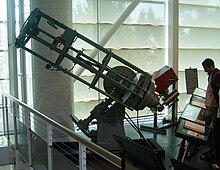Teleskop Ritcheya-Chrétiena
| Ten artykuł od 2013-01 wymaga zweryfikowania podanych informacji. |
Teleskop Ritcheya–Chrétiena (RCT) – rodzaj teleskopu Cassegraina, w którym zarówno zwierciadło główne jak i wtórne mają kształt hiperboloidalny.
Jego nazwa pochodzi od nazwisk dwóch astronomów: Amerykanina George’a W. Ritcheya i Francuza Henriego Chrétiena. Ritchey skonstruował swój pierwszy teleskop (o średnicy 60 cm) w 1927 roku. Drugi z jego teleskopów, o średnicy 102 cm, zbudowany dla United States Naval Observatory, jest do dziś używany przez United States Naval Observatory Flagstaff Station.
Teleskop Ritcheya–Chrétiena jest najczęściej wykorzystywaną konfiguracją wśród wydajnych profesjonalnych teleskopów.
Przykłady teleskopów Ritcheya–Chrétiena
- cztery teleskopy wchodzące w skład Very Large Telescope (Chile)
- dwa teleskopy w Obserwatorium Kecka (Mauna Kea, Hawaje)
- dwa teleskopy z Obserwatorium Gemini (Mauna Kea, Hawaje; Cerro Pachón, Chile)
- dwa teleskopy w Obserwatorium Calar Alto na górze Calar Alto (Hiszpania)
- Wielki Teleskop Kanaryjski w Obserwatorium Roque de los Muchachos (Wyspy Kanaryjskie)
- Teleskop Subaru w Obserwatorium na Mauna Kea (Mauna Kea, Hawaje)
- Teleskop VISTA w Obserwatorium Paranal (Chile)
- Teleskop Angielsko-Australijski w Obserwatorium Siding Spring (Australia)
- Teleskop Nowej Technologii w Europejskim Obserwatorium Południowym (Chile)
- Telescopio Nazionale Galileo w Obserwatorium Roque de los Muchachos (Wyspy Kanaryjskie)
- Teleskop WIYN w Narodowym Obserwatorium Kitt Peak (Stany Zjednoczone)
- Himalajski Teleskop Chandra w Indyjskim Obserwatorium Astronomicznym (Indie)
- Teleskop Ritcheya w United States Naval Observatory Flagstaff Station (Stany Zjednoczone)
- Nordic Optical Telescope (Wyspy Kanaryjskie)
- Teleskop Sloan Digital Sky Survey (Stany Zjednoczone)
- Teleskop w Obserwatorium Rożen (Bułgaria)
- Teleskop Pan-STARRS (Haleakalā, Hawaje)
- Teleskop w Obserwatorium Mont-Mégantic (Mont-Mégantic, Kanada)
- Teleskop w Obserwatorium Loiano (Włochy)
- Teleskop w Obserwatorium Skinakas (Grecja)
- Kosmiczny Teleskop Spitzera
- Kosmiczny Teleskop Hubble’a
- Kosmiczne Obserwatorium Herschela
Media użyte na tej stronie
Ritchey 24" reflective telescope
This picture was taken in July 2004 from an exhibition at Chabot Space & Science Center in Oakland, California.
The caption of the exhibit said:
Ritchey 24-inch Reflecting Telescope
By George W. Ritchey, American Telescope Maker
On loan from Smithsonian Institution
George Willis Ritchey (1864-1945) was the builder of the first successful large American reflecting telescopes.
A telescope designer who perfected the methods for making astronomical mirrors and a master at celestial photography,
George Ritchey worked closely with George Ellery Hale, the phenomenal fund-raiser and organizer of observatories.
Mount Wilson Observatory with its 60-inch and 100-inch reflector telescopes stands today as a monument ot their collaboration.
The first important telescope built by George Ritchey (at Yerkes Observatiory in Wisconsin) was the 24-inch reflector you see here. He made the primary mirror (an f/4 paraboloid) in his shop and Francis G. Pease worked on the cassegrain secondary mirror. Ritchey later photographed many nebulae with this telescope. The pictures were the first opportunity astronomers had to see the true forms and complicated structure of nebulae like the Orion Nebula. But more importantly, the photographs convinced astronomers that reflectors would be the large telescopes on which future research would be based. This 24-inch telescope's mirror became the prototype for the 60-inch and 100-inch mirrors that Ritchey would later make for the Mount Wilson Observatory near Pasadena, California.
The telescope is on a German equatorial mount. The mirror is silvered glass 23.5 inches wide by 2 and 5/8 inches thick. The bottom of the mirror is supported at three pointes and at the edge. The skeleton tube, 7 feet long, held the secondary mirror and photographic accessories. The eyepiece position has an elaborate stage (brass) with a 2 and 1/8 inch threaded opening. The entire stage can be rotated as well as moved precisedly in either axis.
The holder is designed for use with a photographic plate. The drive mechanism (in the .... <the rest of the text were hidden from view>
Autor: HHahn, Licencja: CC BY-SA 3.0
Diagram of Ritchey-Chrétien reflector
M1 = primary mirror (hyperboloid); M2 = secondary mirror (convex hyperboloid); F = focus



